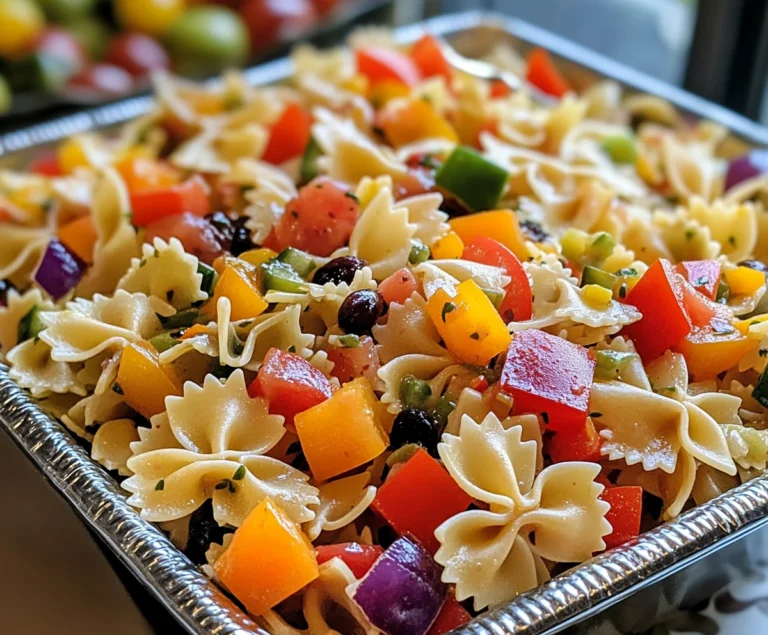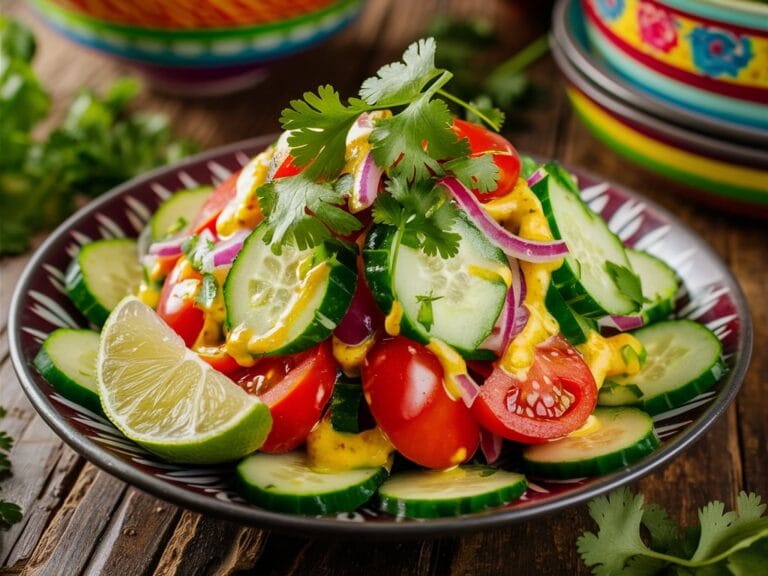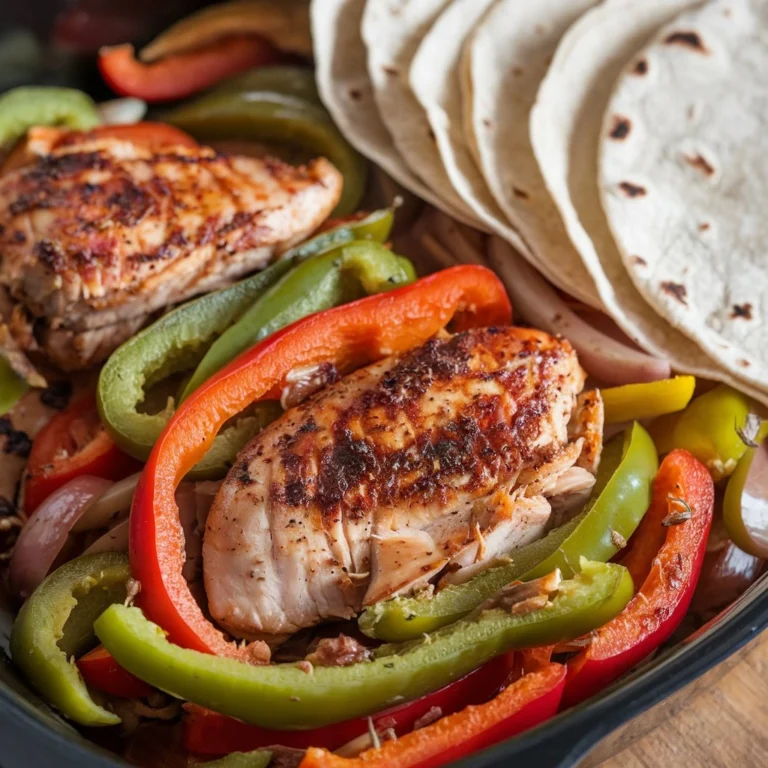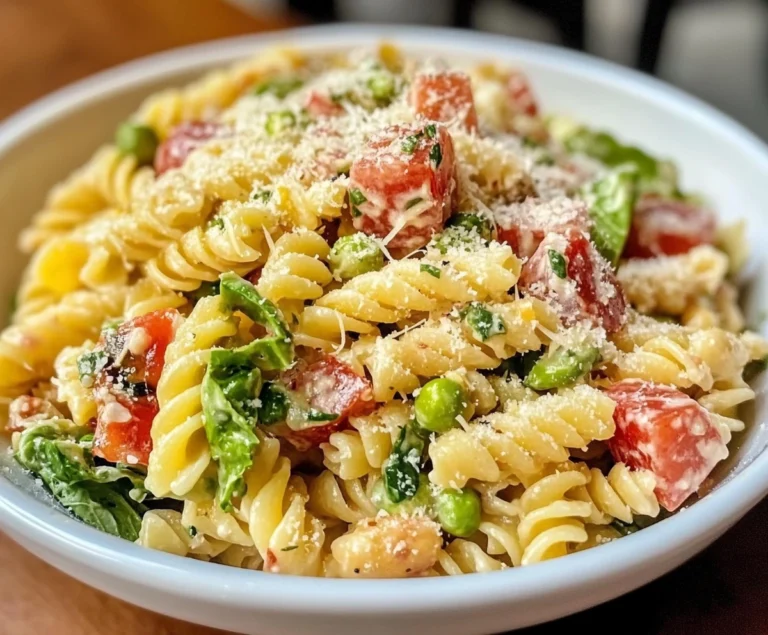Caesar Pasta Salad: A Classic Salad Reinvented with a Pasta Twist
In this comprehensive guide, we’ll explore every aspect of Caesar Pasta Salad, from its history and variations to its nutritional benefits and pro cooking tips. Plus, we’ll answer the most commonly asked questions about this popular dish and suggest perfect sides and beverages to pair with it.
What is Caesar Pasta Salad?
At its core, Caesar Pasta Salad takes everything we love about a traditional Caesar salad—crisp romaine lettuce, tangy Caesar dressing, savory Parmesan cheese, and crunchy croutons—and mixes it with perfectly cooked pasta. This simple twist elevates the salad, turning it into a filling dish that’s perfect for a main course.
The flexibility of Caesar Pasta Salad allows it to be customized according to your preferences. Add grilled chicken or shrimp to boost the protein content, or incorporate vegetables like zucchini, cucumbers, and cherry tomatoes for added freshness and nutrients.
A Brief History of Caesar Salad
To fully appreciate Caesar Pasta Salad, we should first understand its origins in the Caesar salad. This classic dish was invented by Caesar Cardini, an Italian-American restaurateur, in 1924. According to popular lore, the salad was created on a busy Fourth of July when Cardini ran out of ingredients and had to improvise using what was left in his kitchen. The result was a simple but delicious mix of romaine lettuce, croutons, olive oil, Parmesan cheese, raw egg, lemon juice, and Worcestershire sauce, topped with a sprinkle of black pepper.
Since then, Caesar salad has evolved into one of the most popular salads worldwide, often served with variations that include chicken, anchovies, or bacon. The addition of pasta to Caesar salad is a relatively modern innovation, likely emerging from the need for more filling meal options that are still light enough for summer picnics or quick dinners.
Why Add Pasta to Caesar Salad?
Pasta is a natural addition to Caesar salad because it absorbs the flavors of the dressing while providing a more substantial bite. By incorporating pasta, you can turn what was once a side dish into a hearty, balanced meal. This makes Caesar Pasta Salad perfect for everything from casual family dinners to formal occasions like brunches or luncheons.
In fact, adding pasta to salads is a common practice in many cuisines. For example, Tomatillo Pasta Recipe provides a great Mexican-Italian fusion that incorporates pasta in a delightful and flavorful way, much like Caesar Pasta Salad does with Italian-American roots.
Key Ingredients for Caesar Pasta Salad
Pasta
The type of pasta you use in Caesar Pasta Salad plays a significant role in the overall texture and taste of the dish. Bowtie pasta, also known as farfalle, is one of the most popular choices because its shape holds onto the dressing well while offering a slightly firm bite. However, other pasta shapes like penne, fusilli, or rigatoni are also suitable.
- Bowtie Pasta (Farfalle): Bowtie pasta adds a decorative element and is a great choice for absorbing the creamy Caesar dressing.
- Penne: This sturdy, tube-shaped pasta holds its shape well and pairs wonderfully with the salad.
- Fusilli: Spiral-shaped pasta offers more surface area for the dressing to cling to.
- Whole Wheat or Gluten-Free Pasta: For a healthier or gluten-free version, opt for these alternatives.
Romaine Lettuce
Is the star of the Caesar salad and contributes a delightful crunch that contrasts with the softness of the pasta. Romaine is highly recommended for its mild flavor and crisp texture, but you can experiment with other lettuces like kale or butter lettuce if you’re looking for something different.
Caesar Dressing
The dressing is the heart and soul of Caesar Traditionally made from egg yolk, olive oil, lemon juice, garlic, Dijon mustard, Worcestershire sauce, and Parmesan cheese, this dressing provides a tangy and creamy balance to the salad. You can easily find high-quality bottled Caesar dressing in stores, but making your own from scratch allows for a more personalized taste.
If you’re interested in adding extra richness, consider trying a creamy garlic Parmesan sauce, which provides a perfect complement to the flavors in Caesar
Parmesan Cheese
Shaved Parmesan cheese is ideal for Caesar because it offers a sharper, nuttier flavor than grated varieties. Shaving the cheese allows it to melt slightly into the dressing while still maintaining its texture. You could also opt for grated Parmesan or even use pecorino for a slightly saltier profile.
Croutons
Croutons add a delightful crunch to Caesar Pasta Salad, and you can either use store-bought or homemade varieties. You could even experiment with flavored croutons, such as garlic or herb-infused options. For a gluten-free option, you can substitute croutons with roasted chickpeas or gluten-free crackers.
Optional Ingredients
One of the joys of Caesar Pasta Salad is its versatility. Here are some popular ingredients you can add:
- Grilled Chicken: A common addition, grilled chicken turns Caesar Pasta Salad into a protein-packed meal. You could follow a guide like Alice Springs Chicken Recipe to make your chicken extra flavorful.
- Shrimp: For a seafood twist, grilled or sautéed shrimp works wonderfully with the Caesar dressing.
- Bacon: For a smoky flavor, add crispy bacon bits.
- Avocado: For a creamy texture and added healthy fats, diced avocado is a fantastic addition.
- Hard-Boiled Eggs: Chopped eggs can add extra protein and richness to the salad.
How to Make Caesar Pasta Salad: Step-by-Step Instructions
Making Caesar Pasta Salad is simple and can be easily adapted to suit your taste. Here’s a detailed guide:
Step 1: Cook the Pasta
Start by boiling your pasta in salted water. Make sure to cook the pasta until al dente, meaning it should be tender but still firm to the bite. This texture will ensure that the pasta holds up well when mixed with the dressing.
- Pro Tip: Add a tablespoon of olive oil to the boiling water to prevent the pasta from sticking together.
Once the pasta is cooked, drain it and rinse it under cold water to stop the cooking process. This step is crucial for pasta salads, as it helps to cool the pasta and prevent it from getting mushy.
Step 2: Prepare the Romaine Lettuce
While the pasta is cooking, wash and chop the romaine lettuce into bite-sized pieces. If you’re using a head of romaine, make sure to thoroughly dry the leaves, as excess moisture can water down the salad.
Step 3: Make or Assemble the Caesar Dressing
If you’re making homemade Caesar dressing, combine egg yolk, olive oil, lemon juice, Worcestershire sauce, minced garlic, and grated Parmesan in a bowl. Whisk until the dressing is smooth and creamy. If you prefer a shortcut, use store-bought Caesar dressing of your choice.
For an extra garlicky punch, consider using garlic Parmesan sauce as a base for the dressing.
Step 4: Toss the Ingredients Together
In a large mixing bowl, combine the cooled pasta with the romaine lettuce. Pour the Caesar dressing over the salad, tossing gently to ensure everything is evenly coated. Add the shaved Parmesan cheese and croutons, mixing just enough to distribute them without crushing the lettuce or croutons.
Step 5: Add Optional Ingredients
If you’re adding any optional ingredients like grilled chicken, shrimp, or avocado, now is the time to mix them in. Adding a protein like chicken or shrimp makes this dish more substantial and turns it into a full meal.
For inspiration on adding meat, consider trying variations such as the Baked Chicken Cutlet Recipe for a crispy, flavorful chicken that pairs perfectly with Caesar Pasta Salad.
Step 6: Season and Serve
Before serving, taste the salad to check if it needs any additional seasoning. Add a pinch of salt, freshly ground black pepper, or extra Parmesan as needed. Serve immediately or refrigerate for up to two hours if you prefer a colder salad.
Caesar Pasta Salad Variations
One of the best things about Caesar Pasta Salad is its versatility. There are countless ways to modify the dish to suit your dietary needs or preferences. Here are some popular variations:
1. Grilled Chicken Caesar Pasta Salad
Adding grilled chicken is a classic way to turn Caesar Pasta Salad into a protein-rich main course. Simply season chicken breasts with olive oil, salt, pepper, and garlic powder, then grill until fully cooked. Slice the chicken into strips and toss it with the salad. You can also marinate the chicken with lemon and herbs for extra flavor.
For more ideas on incorporating chicken, you might want to try Alice Springs Chicken for a flavorful twist.
2. Shrimp Caesar Pasta Salad
For seafood lovers, shrimp is an excellent addition to Caesar Pasta Salad. Grill or sauté the shrimp with garlic and olive oil, then toss them into the salad. The sweet, juicy shrimp pairs beautifully with the tangy Caesar dressing.
3. Vegetarian Caesar Pasta Salad
For a meatless option, skip the chicken or shrimp and load your salad with roasted vegetables like zucchini, bell peppers, and cherry tomatoes. Roasted or grilled vegetables add extra texture and flavor, making the dish more filling. You can even try variations like the Zucchini Mushroom Recipe for more inspiration on adding nutritious veggies.
4. Gluten-Free Caesar Pasta Salad
To make this salad gluten-free, simply swap regular pasta for a gluten-free version, such as chickpea pasta or rice pasta. You’ll also want to use gluten-free croutons or substitute them with roasted chickpeas for a similar crunchy texture.
5. Vegan Caesar Pasta Salad
To make a vegan version, you can substitute the Caesar dressing with a vegan-friendly option made from cashews, nutritional yeast, and Dijon mustard. Replace the Parmesan cheese with vegan cheese or omit it altogether, and use chickpea-based pasta for a protein boost.
6. Caesar Pasta Salad with Bacon
If you’re looking to add a smoky flavor, crispy bacon bits are the way to go. Cook the bacon until crispy, crumble it, and sprinkle it over the salad just before serving for an indulgent treat.
Nutritional Information and Health Benefits of Caesar Pasta Salad
While Caesar Pasta Salad is undeniably delicious, you might wonder about its nutritional content. The calorie count and nutritional breakdown will vary depending on the specific ingredients used, such as the type of pasta, dressing, and any optional add-ins like chicken or bacon.
Nutritional Breakdown (per serving, approximate):
- Calories: 377 kcal
- Carbohydrates: 48g
- Protein: 12g
- Fat: 15g
- Fiber: 3g
Health Benefits of Key Ingredients:
- Romaine Lettuce: Romaine is rich in vitamins A and K, as well as antioxidants that promote eye health and help fight inflammation.
- Parmesan Cheese: A great source of calcium and protein, Parmesan also adds flavor without needing large quantities.
- Olive Oil: If using a high-quality olive oil in your Caesar dressing, you’ll benefit from heart-healthy monounsaturated fats and antioxidants.
- Grilled Chicken: Adding chicken boosts the protein content, making the dish more satiating and a great option for post-workout meals.
- Whole Wheat Pasta: If you use whole-wheat pasta, you’ll increase the fiber content, which aids digestion and helps keep you full for longer.
For those aiming to make their Caesar Pasta Salad healthier, there are a few tweaks you can implement:
- Use a low-fat Caesar dressing or make your own dressing with Greek yogurt instead of mayonnaise.
- Opt for whole-grain pasta or gluten-free varieties if you are watching your carbohydrate intake.
- Increase the vegetable content by adding more fresh or roasted vegetables to the salad.
Frequently Asked Questions (FAQs)
1. Can I Make Caesar Pasta Salad Ahead of Time?
Yes! Caesar Pasta Salad can be made ahead of time, but it’s important to store the components separately. Keep the pasta, lettuce, dressing, and croutons in individual containers and only toss everything together just before serving. This will help maintain the crunch of the lettuce and croutons.
2. What is the Best Pasta for Caesar Pasta Salad?
Bowtie pasta is one of the most popular choices, but penne and fusilli also work well. The key is to use a pasta shape that holds onto the dressing without becoming too soft.
3. How Can I Make Caesar Pasta Salad Healthier?
There are several ways to lighten up Caesar without sacrificing flavor. Use a low-fat Caesar dressing or make your own with Greek yogurt, substitute regular pasta with whole-wheat or gluten-free options, and add extra vegetables like zucchini or bell peppers. You can also reduce the amount of cheese and croutons.
4. Is Caesar Gluten-Free?
It can be! To make a gluten-free version, simply use gluten-free pasta and croutons. Everything else, including the romaine lettuce, dressing, and cheese, is naturally gluten-free.
5. Can I Add Different Proteins?
Absolutely! While grilled chicken is the most popular protein addition, you can also add shrimp, bacon, or hard-boiled eggs. For vegetarians, tofu or tempeh are great plant-based protein options.
6. What Can I Serve With Caesar Pasta Salad?
Caesar Pasta Salad is versatile enough to be served on its own, but if you’re looking for side dishes, consider pairing it with a fresh and light Mexican Cucumber Salad or a simple garlic bread.
Perfect Pairings: What to Serve with Caesar Pasta Salad
While Caesar can be a complete meal in itself, you can pair it with complementary dishes for a more elaborate spread. Here are some pairing ideas:
- Garlic Bread: The crunchy and garlicky flavors of garlic bread perfectly complement the creaminess of Caesar .
- Grilled Vegetables: Serve grilled or roasted vegetables such as zucchini, asparagus, or bell peppers to add extra color and flavor to your meal.
- Soup: A light soup like Cucumber Gazpacho pairs beautifully with Caesar , especially during warmer months.
Beverage Pairings:
- White Wine: A crisp Chardonnay or Sauvignon Blanc works well with the creamy dressing and the freshness of the salad.
- Iced Tea: For non-alcoholic options, a cold glass of iced tea with a splash of lemon provides a refreshing counterbalance to the richness of the salad.
Conclusion
Caesar Pasta Salad is more than just a variation of a traditional Caesar salad—it’s a versatile, delicious, and crowd-pleasing dish that can be adapted to suit any occasion. Whether you’re hosting a summer barbecue, looking for a quick weekday dinner, or preparing a dish for a potluck, this recipe offers endless customization options to meet your dietary preferences and flavor cravings.
By adding protein like grilled chicken or shrimp, opting for gluten-free pasta, or increasing the vegetable content, you can tailor this dish to fit your nutritional needs. And with simple, fresh ingredients, it’s a dish that can easily become a staple in your recipe rotation.
Try incorporating flavors from recipes like Zucchini Mushroom Salad or experiment with adding different sauces like a garlic Parmesan base. However you choose to enjoy it, Caesar Pasta Salad is sure to be a hit!







